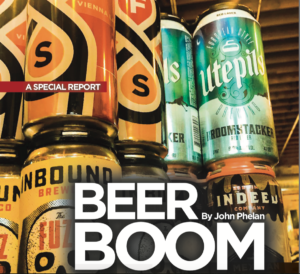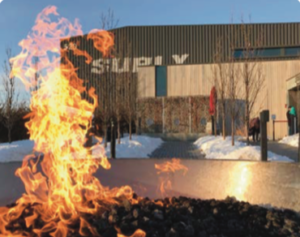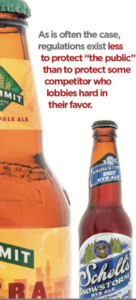Beer boom
This article originally appeared in the Winter 2019 Issue of Thinking Minnesota, now the second largest magazine in Minnesota. To receive a free trial issue, send your name and address to [email protected].
 When I was growing up in England, American beer had a pretty bad reputation. All you ever saw were light, lager beers with lots of bubbles and little taste. Overall, most people shared the opinion of Monty Python’s Eric Idle, who said in 1982 that American beer was “close to water.” That impression has changed in the last decade. When I first visited Minnesota in 2007, I was surprised to discover quality beer like Summit and Surly. The next year I visited the Sierra Nevada brewery in Chico, California and the Anchor Steam brewery in San Francisco. Shortly afterwards, I found Sierra Nevada’s Pale Ale on tap in one of my regular haunts in London and Anchor Steam in a pub down the road. Nowadays, any half-decent British pub will pour American craft beers. Exports of American craft beers grew by 33 percent in 2015; at the 2017 European Beer Star competition, American beers won 33 awards, edging out beers from around the world to win gold in 12 categories. We have come along way from the watery, fizzy domestics of my youth.
When I was growing up in England, American beer had a pretty bad reputation. All you ever saw were light, lager beers with lots of bubbles and little taste. Overall, most people shared the opinion of Monty Python’s Eric Idle, who said in 1982 that American beer was “close to water.” That impression has changed in the last decade. When I first visited Minnesota in 2007, I was surprised to discover quality beer like Summit and Surly. The next year I visited the Sierra Nevada brewery in Chico, California and the Anchor Steam brewery in San Francisco. Shortly afterwards, I found Sierra Nevada’s Pale Ale on tap in one of my regular haunts in London and Anchor Steam in a pub down the road. Nowadays, any half-decent British pub will pour American craft beers. Exports of American craft beers grew by 33 percent in 2015; at the 2017 European Beer Star competition, American beers won 33 awards, edging out beers from around the world to win gold in 12 categories. We have come along way from the watery, fizzy domestics of my youth.
The craft brewing boom in Minnesota
The pace of this beer change has been staggering. In 2007, there were fewer than 10 breweries and brewpubs statewide. A decade later, the total number has reached over 170 (an increase of 1,600 percent). In 2018 alone, 29 new breweries and brewpubs opened, accounting for 17 percent of Minnesota’s estimated 170 total. While the craft beer boom has been a nationwide phenomenon, Minnesota has been something of a market leader. It now ranks 13th nationally for breweries per capita and 10th highest for craft beer consumption. Each adult Minnesotan (21+) drinks, on average, five gallons of craft beer each year. The trend shows little sign of slowing as new breweries continue to open.
But the location of these brewhouses is expanding. In 2016, about half the new breweries were in the Twin Cities, but a year later, the majority of new breweries were in Greater Minnesota: Portage Brewing Company in Walker near Leech Lake, population just short of 1,000; Ashby Brewing Company in Ashby near Fergus Falls, population of 436; and Karst Brewing in Fountain near Lanesboro, population of 413. 
Why the craft brewing industry grew
The craft beer industry boom is similar to the growth of any industry in a free market. Economic growth ultimately depends on the quality of government policies and institutions. These affect incentives to innovate, start a business, hire workers, and invest in physical and human capital. If policies are reformed to increase economic activity, then investment and labor input expand. This is as true for the individual industry as it is for the economy as a whole.
The growth of America’s craft brewing industry offers an excellent illustration. There were 666 breweries open nationwide in 1935, but this number fell as larger breweries producing light, lager beers increased their market share at the expense of smaller, local breweries. The Ernst Fleckenstein Brewing Company, founded in St. Paul in 1855 and relocated to Faribault two years later, closed in 1964. Duluth’s Fitger’s Brewing Company, opened in 1881 as the Lake Superior Brewery, closed in 1972. The Peter Pub Brewing Company in Winona, which traced its origins back to 1856, closed in 1973. By the mid-1970s, American brewing was in a parlous state. There were fewer than 45 breweries in the U.S. and many of the remaining smaller, regional ones were on the verge of bankruptcy.
The challenges America’s smaller brewers faced stemmed from a combination of tax and regulatory problems. In terms of tax, high rates of excise tax—a flat rate per barrel produced—hit small brewers disproportionately hard. Representatives of these small brewers pushed periodically for these taxes to be lowered, but made little progress. In 1961, William O’Shea, executive secretary of the Brewers Association of America, said, “Hope has now vanished, as have so many of the small local brewers who needed this relief to stay in business.”
Fortunately, positive reforms were afoot, and help came from an unexpected quarter. The U.S. Brewers Association, which represented larger brewers, supported relief for the smaller operations. Then Congress, in the teeth of opposition from certain church groups and the Center for Science in the Public Interest (a foe of the brewing industry to this day), passed a measure in 1976 that reduced the federal excise tax by a 22 percent cut on the first 60,000 barrels produced. Only breweries making fewer than two million barrels per year were eligible.
Next, came regulatory reform. Many early craft brewers started out as home brewers. When domestic light lagers started dominating the marketplace, home brewing was one way to inject some variety into beer drinking. But, prior to February 1st, 1979, home brewing was illegal.
California home brewers approached Senator Alan Cranston, pointing out that while wine making had been made legal in the repeal of Prohibition in 1933, home brewing remained against the law. In October 1978, President Jimmy Carter signed into law H.R. 1337, a federal transportation bill, which, owing to the quirks of the D.C. legislative process, made it legal for any household to produce beer for personal or family use without being taxed. The stipulation was production needed to remain at less than 200 gallons a year for a household with two or more adults (18+) or less than 100 gallons a year for a household with one adult.
Deregulation enabled innovative brewers to enter the market. In 1976, a home brewer named Jack McAuliffe founded New Albion Brewing, America’s first craft beer brewery, in Sonoma, California. More recently, it has been estimated that 90 percent of craft brewers begin as home brewers. Neil Miller, one of the owners of Head Flyer Brewing, which opened in Northeast Minneapolis in 2017, had been home brewing for 10 years before going into business. Coupled with this deregulation, lower excise taxes both incentivized craft brewers to get started and enabled them to retain the capital to grow once they did. In 1984 there were 18 microbreweries and 76 non-craft and regional breweries nationwide. Ten years later, those figures were 537 and 22, respectively. In 2017, there were 5,301 breweries, of which 5,234 are craft breweries, contributing $68 billion to the American economy and supporting almost a half-million jobs in 2016. One group estimated that more than 78.5 percent of drinking-aged adults in America live within 10 miles of a brewery. By contrast, the number of “macro” breweries fell from 72 to just 19 between 1979 and 2012; their market share fell from 97 percent to 80 percent over the same period.
Minnesota was relatively early to this boom. In 1986, Mark Stutrud, a native of South Dakota, opened Summit Brewing in the old building of a truck parts company on St. Paul’s University Avenue. Using a brewhouse bought from Germany, Summit was the first new brewery to begin operations in the Twin Cities since Prohibition. The following year, Stutrud’s Great Northern Porter captured first place at the Great American Beer Festival. In 1991 Summit expanded, increasing capacity from 5,000 to 12,000 barrels per year. The next year, Summit moved to its present site at the Crosby Lake Business Park in St. Paul, where it currently produces 130,000 barrels a year, making it the second largest brewery in Minnesota after the August Schell Brewery and the 29th largest craft brewery in the U.S.
The regulatory and tax environment for craft brewers has continued to evolve. Beginning in Washington state in 1982,state legislators in all 50 states legalized brew pubs—breweries with restaurants or pubs on the premises—with Minnesota legalizing them in 1987. Brewpubs offer small breweries an easy way to distribute their beer circumventing the logistic or regulatory challenges of distribution to other bars or restaurants.
The Tax Cuts and Jobs Act, passed by Congress in December 2017, reduced the federal excise tax to $3.50 per barrel on the first 60,000 barrels for domestic brewers producing fewer than 2 million barrels annually. This was originally partof the Craft Beverage Modernization andTax Reform Act, introduced by Minnesota Rep. Erik Paulsen and Oregon’s Sen. Ron Wyden.
For all their success, we should not overlook the risks these entrepreneurs take. Capitalism is a loss system as muchas a profit system and many enterpris- ing brewers have failed. Politicians likePresident Obama and Sen. Elizabeth Warren too often see successful entrepreneurs and assume their success comes easily. They don’t see the unsuccessful entrepreneurs. In 1984, six of the 25 microbreweries that had opened in North America since 1976 had gone out of business, including New Albion in 1982. Six Minnesota breweries will have closed by the end of 2018. These will include Great Waters Brewing Company, St. Paul’s oldest brewpub, which shut down in November after 21 years. For many craft brewing enterprises, the marginal effects of taxes and regulation are all important.
Standing on the shoulders of Germans
Minnesota’s new generation of brewers is following in a long tradition. A look back at this history illustrates the threat of government regulation to entrepreneurship and industry.
Many of Minnesota’s settlers came from Germany, a country with one of the world’s greatest beer brewing traditions. The settlers started home brewing as soon as they arrived. The first “commercial”brewery in Minnesota was started in 1849 by Anthony Yoerg, an immigrant from Bavaria, and is located today near the parking ramp for the Science Museum of Minnesota. Yoerg’s beer was a lager, most likely light to medium amber in color. It may have been similar to Firebrick brewed today by Schell in New Ulm, the second oldest brewery in the U.S., founded by another German immigrant in 1860. Other German immigrants to Minnesota would make their names famous as brewing entrepreneurs, such as Jacob Schmidt, Theodore Hamm, and Gottlieb Gluek, whose name lives on in a bar on North 6th Street in Minneapolis.
The effects of government regulation made themselves felt in the most spectacular way with the passage of the Volstead Act in 1919, which enacted Prohibition.
This devastated the brewing industry. More than 1,000 domestic companies were making beer when the 18th Amendment became law. In 1934, a year after it was repealed, there were just 31 remaining companies. At least 20 Minnesota breweries closed in 1920 alone, but others survived by switching products. The Kiewel Brewery in Little Falls used its former cold beer rooms to churn and keep ice cream and produce non-alcoholic malt beverages. Other breweries took more drastic measures. In 1924, the Pitzl Brewery of New Munichwas charged with illegally selling beer, so the owner, Mathew Pitzl, moved his brewery to Estevan, Saskatchewan on a 14-car Soo Line train.
Tax and regulatory barriers remain
While the tax and regulatory environment for craft brewers is much better now than it was in the 1970s, there is still work to be done.
Minnesota’s beer excise tax rates rank 10th highest in the U.S. Because beer taxes are often collected at other points in the supply chain, the only tax a consumer will see printed on their receipt is the applicable state or local sales tax. But Minnesota is one of the states that specify a higher alcoholic beverage sales tax rate in lieu of the general sales tax rate. Beer retailers are taxed at $0.15 per gallon and then an alcohol-specific sales tax of 9 percent applied at the time of the sale, instead of the state’s 6.875 percent general sales tax rate.
Regulations are, perhaps, the biggest problem facing enterprising craft brewers in Minnesota. As is often the case, regulations exist less to protect “the public” than to protect some competitor who lobbies hard in their favor. This was seen in the battle over the so-called “Surly Bill” in 2011.
After the repeal of Prohibition, Minnesota joined many other states by establishing a three-tier system that required breweries to sell their beer only to independent wholesale distributors, who in turn would sell only to independent retailers (liquor stores, restaurants and bars). The legalization of brewpubs in 1987 went some way towards ending this system and bringing back the brewery owned “saloons” which had been prevalent in the U.S. before Prohibition. 
But regulations still limited the size of brewpubs. In 2011, Surly Brewing owner Omar Ansari announced plans to build a $20 million brewery in Minneapolis that would include a 60,000-square-foot, two-story brewery, a 250-seat restau- rant, a 30-foot bar, and a beer garden. His plans were illegal under state law. These laws plainly do not exist to protect Minnesota’s drinkers from the possibility of drinking quality beer in pleasant surroundings but to protect the state’s beer vendors from unwanted competition. Indeed, the Minnesota Licensed Beverage Association (MLBA), the lobbying group for the state’s licensed beverage retailers, lobbied hard against any change in the law, even threatening to stop selling Surly’s products.
Ultimately, Ansari had the chutzpah—not to say a just cause—to face down the MLBA and get a change in the law. Production breweries won the right to operate and sell their own beer onsite in a taproom. Those whose annual production is less than 20,000 barrels can also sell their beer directly to consumers in growlers and 750ml bottles. They can operate restaurants at their breweries, as well, which brings them closer to brewpubs. These restaurants-plus-breweries can pour their own beer and operate a full bar, including non-house beers, wine, and hard liquor. They cannot distribute or package their beer—except for onsite growlers and 750ml bottle sales for off- site consumption—but they can operate multiple locations and serve their beer at them. (In contrast, a production brewery can only operate one taproom.) Finally, brewpubs are capped at brewing no more than 3,500 barrels per year.
This partial unraveling of Minnesota’s three-tier system in recent years has coincided with the incredible explosion of new breweries and brewpubs in the state. This is another example of how, when the incentives are right, economic activity expands. 
It also shows that further deregulation could bring further expansion. Policy makers should eliminate the 3,500-barrel annual limit for brewpubs, and allow brewpubs to distribute their beer for off-site sales like production breweries. Production breweries should be allowed to sell beer, wine, liquor, or spirits from other producers in their taprooms and ought to be allowed to open more than one taproom in the state. Municipalities should also repeal codes that prohibit breweries from operating restaurants.
Thanks to the tax cuts and deregulation of recent decades, brewing in Minnesota is experiencing a Golden Age. With further legislative action favoring beer entrepreneurs and their consumers, it can get brighter still.
John Phelan is an economist with the Center of the American Experiment. He worked at Capital Economics in London, where he wrote reports ranging from the impact of Brexit on the British economy to the effect of government regulation on cell phone coverage. John has written for City Am in London and for the Wall Street Journal in both Europe and the US. He has also been published in the journal Economic Affairs.